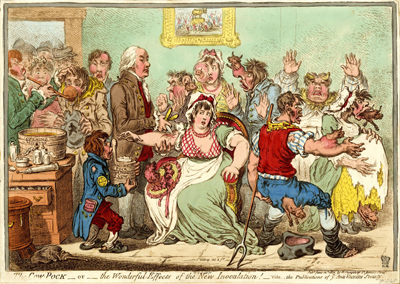The Cow-Pock, or the Wonderful Effects of the New Inoculation!
This hilarious or disgusting print (depending upon your tolerance for the grotesque) purports to show an attractive but fearful young woman being inoculated against against smallpox using the vaccination method championed by Edward Jenner which used serum from a cowpox-infected source—"hot from ye cow"—rather than using matter from an actual smallpox victim. Through various tests, Jenner argued (and proved) that the vaccination method (so named because "vacca" is Latin for "cow") was every bit as effective as the traditional variolation method in preventing smallpox infections but much safer because cowpox is milder and less deadly.

[June 12, 1802]
© Trustees of the British Museum
The dispassionate (or rather oblivious) scientist performing the procedure is usually thought to be a portrait of Jenner himself. But a comparison of Gillray's doctor with portraits of Jenner (~1804) and William Woodville (~1802), head of the Smallpox and Inoculating Hospitals at St. Pancras and by 1802 one of Jenner's most vocal supporters, may suggest that it is Woodville, not Jenner, who is depicted. Or that Gillray intended a composite portrait combining features from both Woodville and Jenner.

© Wikimedia, British Museum, Royal College of Physicians
The setting of Gillray's print is almost certainly the St. Pancras Smallpox Inoculating Hospital. The assistant holding the tub of serum has a patch labeled "Pancras" and the long line of patients suggest that this is a specialty hospital. Gillray's vaccinator has a high forehead and snow-white hair much more like the Woodville portrait. Portraits of Jenner (including this one) show a man with hair that is sandy-colored and somewhat curly. The pursed mouth of Gillray's physician is also somewhat more like Woodville than Jenner. The stubby nose, however, resembles the portrait of Jenner. And it was the news, announced 3 June 1802 in the Morning Post Gazetteer, of a Parliamentary award of £10,000 to Jenner that likely prompted Gillray's print.
But if there is some potential ambiguity surrounding the identity of the physician in Gillray's print, that is not the only matter of dispute. Though Jenner's vaccination method had gained some ground in England (and much moreso on the continent) there was a potent anti-vaccination minority which violently opposed it. Some were simply old-school physicians who had a vested interest in the traditional approach (variolation) and were not willing to change their practice. Others opposed it on religious grounds arguing that smallpox was an expression of God's will and that attemping to avoid it was immoral. And finally, there were those who feared the mixing of animal and human matter would result in the monstrous mutations shown in Gillray's print. One of the most vitriolic of the anti-vaxxers was Benjamin Mosely, M.D. (1742-1819), who according to the History of Vaccines
... compared "Cow-Pock" to "Cow-Dung," and gave graphic descriptions of supposed "nasty, filthy eruptions" he had seen in children who had been vaccinated; he claimed to have seen a whole series of new diseases, including Facies Bovilla, or Cow Pox Face, Scabies Bovilla, Cow Pox Itch or Mange, Tinea Bovilla, or Cow Pox Scaldhead. Most terrifying of all were his case histories, like the stories of poor Sarah Burley, "whose face was distorted, and began to resemble that of an Ox; and Edward Gee who was covered with sores, and afterwards with patches of Cow's Hair," as a result of inoculation by one of the "cow poxers," as Moseley derisively termed them.
It is symptomatic of Gillray's virtuosity (and business sense) that the print has been cited in both the denigration and support of Jenner's methods. Those who argue that Gillray is satirizing Jenner's methods point to the "wonderful effects of the new inoculation:"—with cows or horns sprouting from cheeks, noses, arms, and forehead— and the picture on the wall suggesting that the enthusiasm for the vaccine is equivalent to the Israelites' misguided worship of the golden calf in Exodus 32. The Jenner supporters, on the other hand, point to Gillray's caption "Vide the Publications of ye Anti-Vaccine Society," and suggest that Gillray is simply exaggerating and thereby satirizing the absurd claims of the anti-vaccine camp.
Both perspectives may be missing the point. After all, both vaxxers and anti-vaxxers could buy his work, Gillray might have said. His job was not to take sides, but to create a striking visual image whose wit and artistry would provoke discussion and sell prints. And no one can doubt that he suceeded. Two hundred years later, there is scarcely a single article about the vaccination controversy that does not include Gillray's The Cow-Pock, or the Wonderful Effects of the New Inoculation! That is what Gillray and his publisher, Hannah Humphrey, would call SUCCESS.
Sources and Reading
- Commentary from the British Museum on The Cow-Pock, or the Wonderful Effects of the New Inoculation!.
- Draper Hill, Fashionable Contrasts, 1966, #94
- "Edward Jenner," Wikipedia
- "Edward Jenner and the history of smallpox and vaccination," Baylor University Medical Center Proceedings
- "A Look at Contemporary Reactions to Early Vaccination," British Newspaper Archive
- "William Woodville," Dictionary of National Biography
- Thomas Wright and R.H. Evans, Historical and Descriptive Account of the Caricatures of James Gillray #519.
- Thomas Wright and Joseph Grego, The Works of James Gillray, the Caricaturist; With the History of His Life and Times, p. 289-290.
Comments & Corrections
NOTE: Comments and/or corrections are always appreciated. To make that easier, I have included a form below that you can use. I promise never to share any of the info provided without your express permission.